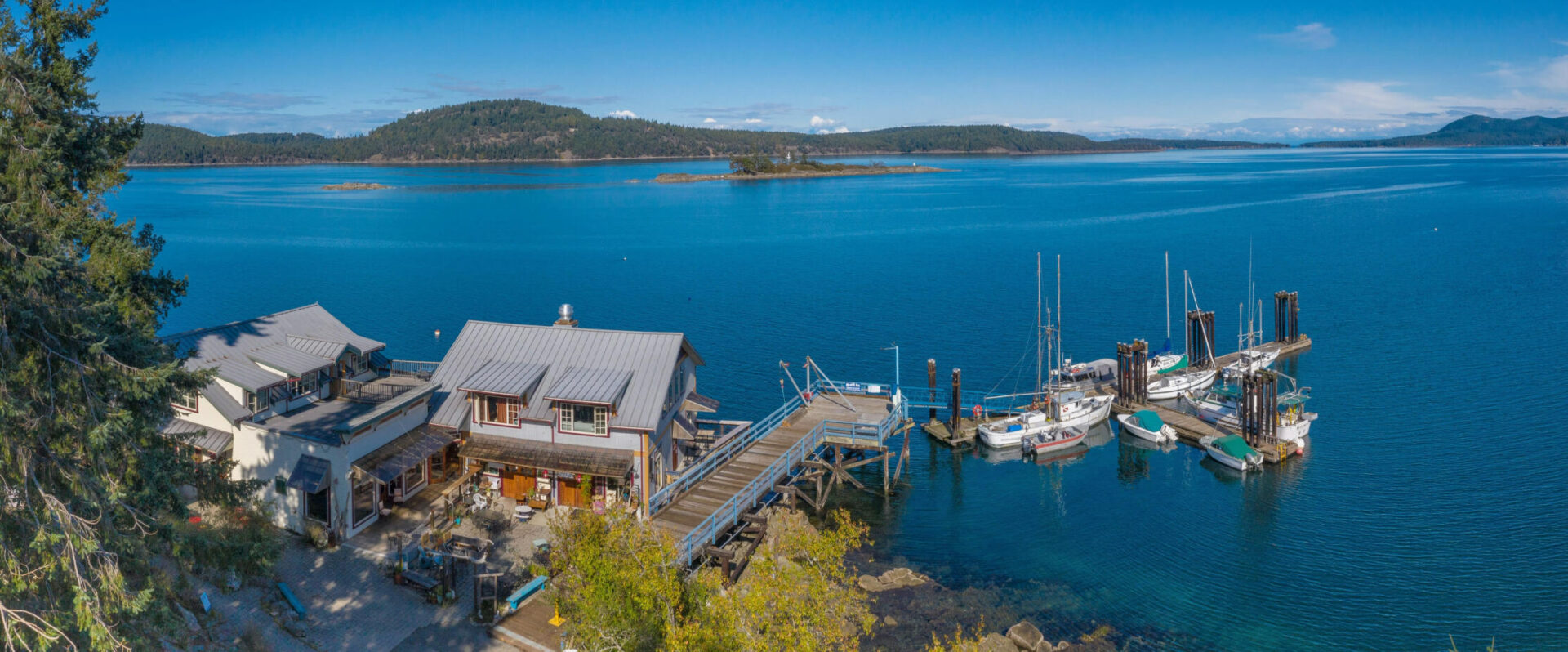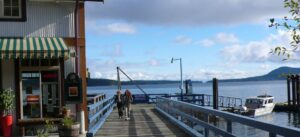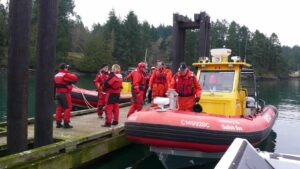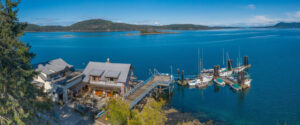In the early hours of February 23, 1998, those of us who were living close to Hope Bay awoke to the alarming sound of sirens and the fiery glow sparking over the trees. The venerable Hope Bay General Store was ablaze, and while the volunteer firefighters were able to contain it, they couldn’t save the structure.
Rising from the ashes, however, was not new to Hope Bay. It had done it before and it would do it again.
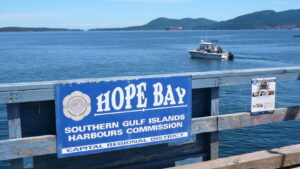
Originally built in 1905 by Robert Corbett to serve as the post office and general
store, that first structure also functioned as the island’s social hub. Wherever the mail was delivered, the party could be found. Well before the post arrived, locals would gather to visit, to await the ferry and to do their shopping, so it was not surprising that two rivaling ports competed for this lively business: Hope Bay and Port Washington. Port Washington was the site of an earlier wharf, built in 1891. Both sites lobbied for the ferry and post office, and both won—on and off. Politically, the areas were at ends as well and according to the late David Davidson of Roesland, parents used to threaten their children if they were naughty by saying, “If you don’t behave, I’ll send you over to Hope Bay.” Port Washington had been named after the first postmaster, Washington Grimmer, who at one time brought the mail to North Pender by rowboat from Mayne Island.
That 1998 Hope Bay fire wasn’t the first. The store had gone up in flames in 1912, but was quickly rebuilt. The Corbett family operated the business for 42 years, eventually selling it in 1956. After this, a series of owners tried their hand at the enterprise with varying levels of success. It flourished and it floundered as Hope Bay continued the tug-of-war with Port Washington for the lucrative ferry and mail trade and later to be the commercial centre. Even though both lost out eventually when the ferry terminals shifted and the Driftwood Centre became the commercial hub, in the 1990s it seemed Hope Bay had found its place in the heart of the island. Poets, musicians and performers entertained outdoor audiences, locals brought their visitors to relax, dine and shop here and to sip espressos by the store’s old potbellied stove in winter. It was the beloved old stove, however, that probably started the final blaze. This time there was no quick rebuilding. For five years the charred remains moldered while the fire was investigated and the owner tried to rebuild, eventually running out of funds. Pending sales were rumored but never came to fruition until several locals came up with a plan to forge a unique partnership, The Hope Bay Rising Holdings Ltd. Local goldsmith, Peter Binner, who had operated his business out of Hope Bay since 1994, was instrumental in the plan. He recognized that the property, one of the most beautiful spots on the islands overlooking Navy Channel across to Mayne Island and Saturna, would be sold for a private home without intervention. Losing public access to this historic waterfront, its old government docks and this scenic part of paradise would be tragic. Another of the original group, Brent Marsden, who became the project manager of the holdings, remembers: “We didn’t want to see it just become a private home. There is no commercial waterfront space that the public can access on these [Pender] islands, other than marinas.”
So, in April 2003, these two and 25 other heroes got together to purchase the property and to rebuild. The complex was opened with a grand celebration on July 3, 2005 and it would seem that the old rivalry between Port Washington and Hope Bay was tipping in the latter’s favour because now the famous Lions Santa Claus ship, which has been visiting the Gulf Islands and San Juan Islands for over 60 years, was changing ports. Hope Bay won what was probably the last battle.
In 2006, the complex changed hands when Sherrie Boyte and her son Sam purchased the property and opened their real estate office on site, appropriately calling it Dockside Realty. Now home to 11 tenants, with offices, a performing space, galleries and a restaurant, the Hope Bay Store continues to serve visitors and islanders alike as a cultural and recreational hub. And Peter Binner, who’s also the wharfinger, still operates his Goldsmith shop here.
So where does the name Hope Bay come from? Was it called after a nearby landmark, or a ship, or was it meant to reflect the optimistic feelings of its new European settlers? None of these. It was named after Rutherford Hope, who emigrated from England in 1876 to join his brother, David.
Getting Here
Located just 2.5 miles northwest of Razor Point on North Pender on the south side of Navy Channel, the CRD dock has 150 feet of mooring on three floats. While the docks are generally well used, the seaward side of the main float sometimes has space for one or two visiting vessels in settled conditions. It is open to wake from passing boats, including the Saturna ferry, however, and… “There’s a wicked swell if you get a westerly in the Juan de Fuca Strait and a wind against the tide,” Wharfinger Binner, warns. In addition there are two mooring buoys for short-term day use for visitors to the complex. Boats can also anchor in the bay, which has good holding ground in mud, “but not if there’s a southeast wind forecast or that really nasty westerly wind. Anchor in about 30 feet. It shelves off rapidly after that.”
Both Binner and the CRD website caution that overnighting here in winter is not feasible but if you’re considering a visit this fall, call to see if there’s space at the dock or mooring buoys. The usual two hours free for visitors applies at the dock. crd.bc.ca/service/docks-moorage/hope-bay
Exploring
If your two and four-legged crew members are anxious to stretch their legs, explore and sniff, you just might want to take a walk up Hoosen Road. Turn left at the head of the bay just ahead. It’s a quiet road that passes the Bible Camp, several small farms and larger estates. If you walk to the end of the road, ignoring the side road that rises off to the left halfway along, in three kilometres you’ll come to the Mount Menzies trailhead where there are great views from the top. If you want a less strenuous walk, just turn right at Hope Bay onto Clam Bay Road. A short distance away on the left side, Mount Elizabeth Park offers a .64-kilometre loop trail that meanders through the forest.
If it’s a Friday or Saturday you’re really in luck! Head straight ahead on Bedwell Harbour Road and follow it to the left at the stop sign. At the top of the hill is the
Nu-to-Yu Community Thrift Store and a modern and attractive library. We have several friends who won’t visit us on Pender unless it’s a Nu-to-Yu day. Housed in what used to be the old schoolhouse, and staffed by volunteers, this very popular outlet has everything you didn’t know you needed. Downstairs you’ll find everything from small furniture to curtains and tools while upstairs are treasures galore: clothing, shoes, books, kitchen gadgets, ornaments and so much more. Friday mornings, when the new “stock” comes out, are always more crowded. Prices are ridiculously cheap and every penny earned goes back into the community to fund everything from scholarship funds to the island’s RCMSAR vessel.
OK, if it’s a Saturday, and seeing as you have come this far, you might want to walk another half block to the community hall and the bustling Saturday Farmers Market for a taste of the local produce and offerings. Check out the Welcome Poles at the front of the building. An initiative of carver and artist, Victor Reece, of the Tsimshian Nation’s Wolf Clan, and the Pender women, it was called the Mother Bear Project in celebration of earlier women.
Hope Bay has evolved beautifully, so no more fires please!
